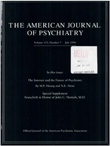Typology of patient-patient assaults detected by videocameras
Abstract
OBJECTIVE: Previous studies of inpatient assault have relied on reports by ward staff, data from which are often incomplete. The authors observed patient-patient assaults with videocameras, obtaining previously unavailable data. In this article they report a systematic method for assault description and classification. METHOD: Assault was defined by behaviors such as hitting, kicking, and choking, with physical contact. Raters reviewed videotapes to make a global judgment of assailant intent to hurt; assault class was based on this judgment. At the same time the raters chose descriptors to better define classes. For external validation, the authors compared classes for resulting injuries, detection by incident reports, and patients' accounts of their motivations. RESULTS: Of 155 assaults detected, 21 were classified as least serious, 57 were in an intermediate group, and 76 were classified as most potentially hurtful. One assault could not be classified. Descriptor variables each made independent significant contributions to assault classification. Almost all assaults detected by incident report or resulting in injuries were in the most serious class. Assailants' claims that they were playing were significantly associated with the least serious class. CONCLUSIONS: With videocameras a variety of interactions between patients involving hitting, slapping, etc., were detected and documented. Some events seemed playful, others seemed intended to hurt, and some were of an intermediate type. This basic, descriptive work can lead to advances in the study of assault predictors.
Access content
To read the fulltext, please use one of the options below to sign in or purchase access.- Personal login
- Institutional Login
- Sign in via OpenAthens
- Register for access
-
Please login/register if you wish to pair your device and check access availability.
Not a subscriber?
PsychiatryOnline subscription options offer access to the DSM-5 library, books, journals, CME, and patient resources. This all-in-one virtual library provides psychiatrists and mental health professionals with key resources for diagnosis, treatment, research, and professional development.
Need more help? PsychiatryOnline Customer Service may be reached by emailing [email protected] or by calling 800-368-5777 (in the U.S.) or 703-907-7322 (outside the U.S.).



